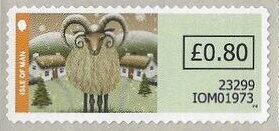Stamp: Loaghtan Sheep and Cregneash (Isle of Man 2023)
Loaghtan Sheep and Cregneash (Isle of Man 2023)
26 October (Isle of Man ) within release Christmas 2023 : Winter Wildlife of Isle of Man (2023) goes into circulation Stamp Loaghtan Sheep and Cregneash face value Various Manx pound
| Stamp Loaghtan Sheep and Cregneash in catalogues | |
|---|---|
| Colnect codes: | Col: IM 2023.10.26-08 |
Stamp is square format.
Also in the issue Christmas 2023 : Winter Wildlife of Isle of Man (2023):
- Stamp - Grey Seal at Laxey Bay face value 2.72;
- Stamp - Grey Seal at Laxey Bay face value Various;
- Stamp - Loaghtan Sheep and Cregneash face value Various;
- Stamp - Loaghtan Sheep at Cregneash face value 1;
- Stamp - Manx Cat at Tynwald Hill face value 2.31;
- Stamp - Manx Cat at Tynwald Hill face value Various;
- Stamp - Mountain Hare at Peel Castle face value 1.28;
- Stamp - Mountain Hare at Peel Castle face value Various;
- Stamp - Puffin at The Sound face value 1.51;
- Stamp - Puffin at The Sound face value Various;
- Stamp - Robin at Old Ballaugh Church face value 80;
- Stamp - Robin at Old Ballaugh Church face value Various;
Stamp Loaghtan Sheep and Cregneash it reflects the thematic directions:
Christmas or Christmas Day (Old English: Crīstesmæsse, meaning "Christ's Mass") is an annual festival commemorating the birth of Jesus Christ, observed most commonly on December 25 as a religious and cultural celebration among billions of people around the world. A feast central to the Christian liturgical year, it is prepared for by the season of Advent or the Nativity Fast and initiates the season of Christmastide, which historically in the West lasts twelve days and culminates on Twelfth Night; in some traditions, Christmastide includes an Octave. The traditional Christmas narrative, the Nativity of Jesus, delineated in the New Testament says that Jesus was born in Bethlehem, in accordance with messianic prophecies; when Joseph and Mary arrived in the city, the inn had no room and so they were offered a stable where the Christ Child was soon born, with angels proclaiming this news to shepherds who then disseminated the message furthermore. Christmas Day is a public holiday in many of the world's nations, is celebrated religiously by the vast majority of Christians, as well as culturally by a number of non-Christian people, and is an integral part of the holiday season, while some Christian groups reject the celebration. In several countries, celebrating Christmas Eve on December 24 has the main focus rather than December 25, with gift-giving and sharing a traditional meal with the family.
A landscape is the visible features of an area of land, its landforms and how they integrate with natural or man-made features. A landscape includes the physical elements of geophysically defined landforms such as (ice-capped) mountains, hills, water bodies such as rivers, lakes, ponds and the sea, living elements of land cover including indigenous vegetation, human elements including different forms of land use, buildings and structures, and transitory elements such as lighting and weather conditions. Combining both their physical origins and the cultural overlay of human presence, often created over millennia, landscapes reflect a living synthesis of people and place that is vital to local and national identity. The character of a landscape helps define the self-image of the people who inhabit it and a sense of place that differentiates one region from other regions. It is the dynamic backdrop to people’s lives. Landscape can be as varied as farmland, a landscape park, or wilderness. The earth has a vast range of landscapes, including the icy landscapes of polar regions, mountainous landscapes, vast arid desert landscapes, islands and coastal landscapes, densely forested or wooded landscapes including past boreal forests and tropical rainforests, and agricultural landscapes of temperate and tropical regions.
Sheep (pl.: sheep) or domestic sheep (Ovis aries) are a domesticated, ruminant mammal typically kept as livestock. Although the term sheep can apply to other species in the genus Ovis, in everyday usage it almost always refers to domesticated sheep. Like all ruminants, sheep are members of the order Artiodactyla, the even-toed ungulates. Numbering a little over one billion, domestic sheep are also the most numerous species of sheep. An adult female is referred to as a ewe (/juː/ yoo), an intact male as a ram, occasionally a tup, a castrated male as a wether, and a young sheep as a lamb.



